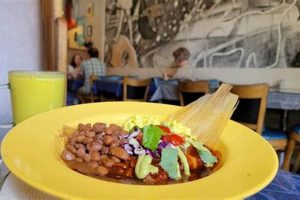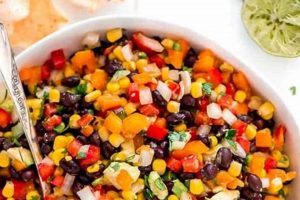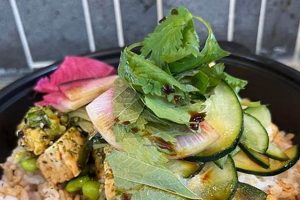Plant-based eating in Puerto Rico involves adapting traditional recipes and utilizing locally sourced fruits, vegetables, and legumes to create dishes free from animal products. Examples include tostones made from plantains, rice and beans cooked without lard or meat, and vegetable stews seasoned with sofrito, a flavorful base of herbs and spices. The movement toward this culinary approach offers a sustainable and ethical alternative to conventional Puerto Rican cuisine.
The adoption of plant-based meals provides several benefits. It can contribute to improved health outcomes by lowering cholesterol and increasing fiber intake. Historically, agriculture in Puerto Rico has relied on a variety of plant-based staples. By emphasizing these indigenous ingredients, the cuisine connects to its cultural roots and promotes a more sustainable food system.
The following sections will delve into specific dishes, explore local markets that offer fresh produce, and discuss the increasing availability of establishments catering to those seeking plant-based dining experiences in Puerto Rico. Further analysis will highlight the cultural adaptation and innovation driving this culinary trend.
Successfully exploring the plant-based culinary landscape of Puerto Rico requires careful planning and awareness of local ingredients and dining practices.
Tip 1: Research restaurants in advance. Many establishments may not exclusively offer vegan options, but their menus often include adaptable dishes. Online resources and restaurant directories can provide valuable information.
Tip 2: Familiarize oneself with common Puerto Rican ingredients. Plantains, beans, rice, and various tropical fruits and vegetables form the foundation of many dishes and are easily incorporated into plant-based meals.
Tip 3: Learn key phrases in Spanish related to dietary restrictions. Knowing how to ask if a dish contains meat, dairy, or other animal products is crucial for effective communication.
Tip 4: Explore local markets and farmers’ markets. These venues offer an abundance of fresh, locally grown produce, allowing for the preparation of plant-based meals at home.
Tip 5: Be prepared to adapt traditional dishes. Request modifications to classic recipes to remove animal products. Examples include ordering rice and beans cooked without lard or asking for vegetable-based fillings for empanadas.
Tip 6: Seek out specialized vegan or vegetarian restaurants. While not as prevalent as traditional eateries, a growing number of establishments cater specifically to plant-based diets.
Tip 7: Inquire about the preparation methods. Ensure that vegetables are not cooked with animal-based broths or fats. Clarifying these details prevents unintentional consumption of non-vegan ingredients.
By adhering to these guidelines, one can confidently navigate the culinary scene and enjoy the flavors of Puerto Rico while maintaining a plant-based lifestyle. Understanding local ingredients and communicating effectively are key to a positive dining experience.
The following section will discuss the availability of plant-based alternatives and the ongoing evolution of this gastronomic trend on the island.
1. Local ingredients
The relationship between locally sourced produce and plant-based cuisine in Puerto Rico is fundamental. The availability of fresh, indigenous ingredients directly influences the feasibility and appeal of adopting a plant-based diet. Prioritizing locally cultivated fruits, vegetables, and legumes minimizes reliance on imported goods, thereby reducing the carbon footprint associated with food transportation. For instance, the cultivation of plantains, a staple crop on the island, allows for the creation of dishes like mofongo and tostones using locally sourced ingredients, thereby facilitating plant-based variations of traditional recipes.
Furthermore, the utilization of local ingredients supports the local economy and promotes sustainable agricultural practices. Farmers’ markets and smaller-scale agricultural operations benefit from increased demand for their products. This, in turn, encourages biodiversity and reduces dependence on monoculture farming. An example is the increased cultivation of batata (sweet potato) and yuca (cassava), both versatile root vegetables used in various plant-based preparations. The use of such ingredients not only diversifies the plant-based diet but also supports local agricultural communities.
In conclusion, local ingredients form the backbone of plant-based eating in Puerto Rico, offering both environmental and economic advantages. By emphasizing locally sourced produce, the cuisine not only gains access to fresh and flavorful ingredients but also contributes to a more sustainable and resilient food system. The connection between local ingredients and this culinary approach is, therefore, integral to its long-term viability and cultural relevance.
2. Adapted traditions
The integration of plant-based principles into Puerto Rican cuisine necessitates adapting traditional recipes, reflecting a shift in dietary preferences and ethical considerations. This adaptation is not merely the removal of animal products but also involves a careful substitution of ingredients to maintain the dish’s authentic flavor profile and cultural significance. Traditional cooking methods, passed down through generations, are re-evaluated to accommodate plant-based alternatives. The cause for this adaptation stems from increased awareness of health benefits, environmental concerns, and animal welfare, leading to a growing demand for plant-based options. The effect is a transformed culinary landscape where traditional dishes are reimagined without compromising their cultural identity.
The importance of adapted traditions within the context of plant-based eating in Puerto Rico lies in its ability to bridge the gap between culinary heritage and contemporary dietary choices. Dishes such as pasteles, traditionally made with pork, can be adapted using plantain masa filled with seasoned vegetables, maintaining the essence of the dish while adhering to plant-based guidelines. Similarly, arroz con gandules, a staple rice dish, can be prepared without the use of ham hock or other animal products, substituting them with vegetable broth and plant-based seasonings. These adaptations demonstrate that culinary traditions can evolve and adapt to meet changing societal needs without losing their cultural relevance.
In conclusion, the adaptation of traditional recipes is a crucial element in the expansion of plant-based eating in Puerto Rico. It allows individuals to embrace plant-based diets while still honoring their cultural heritage. This adaptation not only promotes healthier and more sustainable eating habits but also ensures the continued relevance of Puerto Rican cuisine in a changing world. Challenges remain in educating chefs and consumers about these adaptations, but the overall trend indicates a growing acceptance and integration of plant-based principles within the culinary landscape of Puerto Rico.
3. Plantain prominence
Plantain prominence is a cornerstone of Puerto Rican cuisine, exerting a significant influence on the development and availability of plant-based options. Its versatility and widespread use in traditional dishes make it a key ingredient for adapting and creating meals suitable for vegan diets. The following details explore how plantains shape and enhance plant-based culinary offerings on the island.
- Tostones as a Vegan Staple
Tostones, twice-fried plantain slices, exemplify a naturally plant-based dish that is already deeply embedded in Puerto Rican culinary culture. These are readily available and inherently vegan, serving as a reliable side dish or snack. Their widespread consumption provides a familiar and accessible option for those adhering to plant-based diets, offering a simple entry point into the island’s cuisine.
- Mofongo Adaptations
Mofongo, traditionally made with mashed plantains and pork cracklings, presents an opportunity for adaptation. Vegan versions substitute the pork with vegetables or plant-based proteins, maintaining the dish’s texture and flavor profile. This adaptation demonstrates the potential for transforming iconic dishes to align with plant-based dietary requirements, broadening the appeal of Puerto Rican cuisine to a wider audience.
- Plantain Flour in Baking
Plantain flour is increasingly used in baking and cooking as a gluten-free and plant-based alternative to wheat flour. This ingredient allows for the creation of vegan-friendly versions of traditional pastries and breads. Its application showcases the innovative use of plantains beyond conventional dishes, enhancing the diversity of vegan options available.
- Pltanos Maduros (Sweet Plantains)
Ripe plantains, known as pltanos maduros, offer a naturally sweet and versatile ingredient for desserts and side dishes. Their inherent sweetness requires minimal additional sugar, making them a healthier and plant-based alternative to processed sweets. Their use highlights the naturally occurring plant-based options within Puerto Rican cuisine, contributing to a balanced and nutritious vegan diet.
The prominence of plantains in Puerto Rican cuisine not only provides readily available plant-based options but also fosters culinary innovation. The ability to adapt traditional dishes and create new recipes using plantains underscores their importance in supporting and expanding plant-based eating on the island. This versatile ingredient remains central to both the cultural identity and the evolving culinary landscape of Puerto Rico, connecting tradition with contemporary dietary needs.
4. Sofrito variations
Sofrito, a foundational element of Puerto Rican cuisine, undergoes considerable modification within the context of plant-based cooking. The versatility of sofrito allows for numerous variations that cater specifically to vegan dietary requirements, maintaining the rich flavor profile while excluding animal products. These adaptations are essential for preserving the authenticity of Puerto Rican dishes in their plant-based forms.
- Traditional Ingredients Omission
The traditional preparation of sofrito often includes ingredients such as bacon or ham fat for added depth. In vegan variations, these components are omitted entirely. The omission necessitates a greater reliance on aromatic vegetables and herbs to compensate for the lost umami. The exclusion represents a conscious effort to adhere to vegan principles while retaining the essence of the flavor base.
- Enhanced Vegetable Base
To compensate for the absence of animal fats, vegan sofrito frequently incorporates a more diverse and intensified vegetable base. This may include increased quantities of onions, peppers, and garlic, or the addition of other vegetables such as carrots or celery. The enhanced vegetable content aims to provide a richer and more complex flavor profile, ensuring that the vegan sofrito is as robust and flavorful as its traditional counterpart.
- Herb and Spice Amplification
Vegan sofrito formulations often amplify the use of herbs and spices to elevate the overall flavor. Cilantro, recao (culantro), oregano, and ajes dulces (sweet peppers) are frequently used in larger quantities. The augmented herb and spice mix contributes to a depth of flavor that compensates for the omission of animal-derived components, ensuring that the sofrito remains a central flavor driver in plant-based dishes.
- Oil Infusion Techniques
Infusing oils with garlic, herbs, or smoked paprika introduces additional layers of flavor to vegan sofrito. This technique involves gently heating the oil with the desired aromatics to extract their flavors, then using the infused oil as a base for the sofrito. Oil infusion provides a method for replicating some of the savory notes traditionally imparted by animal fats, enhancing the overall complexity and richness of the vegan sofrito.
These variations demonstrate the adaptability of sofrito within the plant-based culinary landscape of Puerto Rico. The conscious omission of animal products, the enhancement of vegetable components, the amplification of herbs and spices, and the utilization of oil infusion techniques collectively contribute to the creation of vegan sofrito that honors the traditions of Puerto Rican cuisine while adhering to plant-based dietary requirements. The ability to innovate and adapt this foundational element allows for the continued enjoyment of authentic Puerto Rican flavors in a vegan context.
5. Bean diversity
Bean diversity constitutes a critical element in the plant-based culinary landscape of Puerto Rico. The island’s rich agricultural heritage allows for the cultivation and consumption of a wide array of bean varieties, each offering distinct nutritional profiles, textures, and flavors. This diversity directly addresses the nutritional requirements of a plant-based diet, providing essential proteins, fibers, and micronutrients often sought from animal-based sources. The cause of this emphasis on bean diversity stems from both traditional agricultural practices and a growing awareness of the health benefits associated with plant-based protein sources. The effect is a vibrant culinary scene where beans are not merely a side dish but a central component of many plant-based meals.
Examples of this diversity include the use of habichuelas rosadas (pink beans) in stews, frijoles negros (black beans) as a base for rice dishes, and garbanzos (chickpeas) in salads and fritters. Each bean variety offers a unique culinary application. The understanding of these applications holds practical significance for chefs and home cooks alike, enabling the creation of balanced and flavorful plant-based meals. The knowledge also extends to traditional dishes adapted to suit plant-based diets. A traditional rice and beans recipe, arroz con habichuelas, exemplifies this adaptation, where the omission of ham hock or other animal fats necessitates a focus on the inherent flavors of the beans and aromatic vegetables.
In conclusion, bean diversity is not simply an attribute of Puerto Rican cuisine; it is a strategic advantage in promoting and sustaining plant-based eating practices. Challenges persist in educating consumers about the nutritional benefits of various bean types and promoting sustainable agricultural practices that support this diversity. Overcoming these challenges will further solidify the role of bean diversity in the island’s culinary identity and contribute to a healthier, more sustainable food system.
6. Sustainable agriculture
Sustainable agriculture forms a critical foundation for a thriving plant-based food system in Puerto Rico. Its impact spans from the availability of diverse, locally sourced ingredients to the overall ecological health of the island. The direct correlation lies in the ability of sustainable farming practices to provide the fresh produce necessary for plant-based diets while minimizing environmental harm. For instance, agroecological methods, which prioritize biodiversity and soil health, yield a greater variety of fruits, vegetables, and legumes, enriching the potential for plant-based culinary innovation. The reduction of synthetic pesticides and fertilizers safeguards the environment and human health, aligning with the ethical considerations that often motivate plant-based dietary choices. The importance of sustainable agriculture as a component of plant-based eating cannot be overstated, as it addresses both the source and the impact of food production, creating a more responsible and resilient food system.
Examples of sustainable agricultural practices in Puerto Rico include the revival of traditional farming techniques, such as raised-bed gardening and intercropping, which naturally enhance soil fertility and reduce pest infestations. Furthermore, the adoption of organic certification standards ensures that produce meets rigorous environmental and health criteria, promoting consumer confidence in plant-based food choices. The establishment of community-supported agriculture (CSA) programs links consumers directly with local farmers, fostering transparency and supporting the economic viability of sustainable agricultural operations. These programs guarantee a steady market for sustainably grown produce, encouraging farmers to adopt and maintain environmentally friendly practices. The practical significance of this understanding lies in its ability to inform consumer choices and influence food policy, incentivizing the production and consumption of sustainably sourced plant-based foods.
In conclusion, sustainable agriculture is not merely an adjunct to plant-based eating in Puerto Rico but an indispensable element. Challenges remain in expanding sustainable farming practices to meet the growing demand for plant-based foods and in ensuring equitable access to sustainably produced produce. Addressing these challenges requires a multi-faceted approach involving government support, educational initiatives, and community engagement. The long-term viability of a robust plant-based food system in Puerto Rico depends on the continued commitment to sustainable agricultural principles, creating a harmonious balance between food production, environmental stewardship, and human well-being.
7. Health considerations
The intersection of health considerations and plant-based eating in Puerto Rico represents a significant area of interest for both public health and individual well-being. Increased awareness of the potential benefits associated with plant-based diets drives the demand for and adaptation of traditional cuisine. This shift often stems from a desire to mitigate risks associated with chronic diseases prevalent in the population, such as diabetes, cardiovascular disease, and obesity. The cause is multifaceted, encompassing factors such as increased access to nutritional information, rising healthcare costs, and a growing emphasis on preventative health measures. The effect is a gradual transformation of dietary habits, with individuals seeking healthier alternatives to traditional, often heavily meat-based, meals.
Plant-based diets, when appropriately planned, offer several health advantages. They are typically lower in saturated fat and cholesterol while being richer in fiber, vitamins, and minerals. These factors can contribute to improved cardiovascular health, better blood sugar control, and a reduced risk of certain cancers. In the context of Puerto Rican cuisine, adapting traditional dishes such as arroz con gandules or pasteles to exclude animal products allows individuals to enjoy culturally relevant foods while adhering to healthier dietary guidelines. For example, replacing pork in pasteles with seasoned vegetables significantly reduces the fat content while maintaining the dish’s cultural identity. The practical significance of this understanding lies in its potential to inform public health initiatives, empower individuals to make informed dietary choices, and encourage restaurants and food producers to offer healthier plant-based options.
In conclusion, health considerations play a pivotal role in shaping the landscape of plant-based dining in Puerto Rico. Challenges remain in ensuring that plant-based diets are nutritionally complete and accessible to all segments of the population. However, the growing awareness of the health benefits associated with plant-based eating, coupled with the adaptation of traditional cuisine, presents a promising opportunity to improve public health outcomes and promote a more sustainable and equitable food system on the island.
Frequently Asked Questions
The following section addresses common inquiries regarding the availability, composition, and cultural integration of plant-based food options in Puerto Rico. These questions aim to provide clarity and insight into this evolving culinary landscape.
Question 1: Is adherence to a plant-based diet achievable given the prominence of meat in traditional Puerto Rican cuisine?
Yes, it is achievable. While meat plays a significant role in many traditional dishes, the abundance of locally sourced fruits, vegetables, and legumes provides a foundation for creating plant-based alternatives. Furthermore, the adaptation of traditional recipes and the increasing availability of specialized vegan establishments facilitate the adoption of a plant-based lifestyle.
Question 2: What are the primary nutritional considerations when adopting a plant-based diet in Puerto Rico?
Ensuring adequate protein intake, obtaining sufficient vitamin B12, and maintaining a balanced intake of essential fatty acids are key considerations. While beans, lentils, and other legumes are readily available protein sources, supplementation may be necessary to meet vitamin B12 requirements. A diversified diet including nuts, seeds, and plant-based oils helps ensure an adequate intake of essential fatty acids.
Question 3: How does plant-based dining contribute to sustainability in Puerto Rico?
By reducing reliance on animal agriculture, plant-based diets can contribute to lower greenhouse gas emissions, decreased water consumption, and reduced land degradation. Furthermore, the emphasis on locally sourced produce supports local farmers and promotes sustainable agricultural practices, fostering a more resilient food system.
Question 4: Are there specific traditional Puerto Rican dishes that are easily adapted to be plant-based?
Yes. Tostones (fried plantains) are inherently vegan. Arroz con gandules (rice with pigeon peas) can be made plant-based by omitting the traditional pork. Habichuelas guisadas (stewed beans) can be prepared without animal fats or broths. These dishes showcase the inherent adaptability of Puerto Rican cuisine to plant-based dietary requirements.
Question 5: Where can one find plant-based dining options in Puerto Rico?
Plant-based dining options are increasingly available in urban areas, particularly in San Juan and other tourist destinations. Specialized vegan and vegetarian restaurants are emerging, and many traditional restaurants offer plant-based alternatives or are willing to accommodate dietary requests. Online resources and restaurant directories can provide information on specific establishments.
Question 6: What are the main challenges in promoting plant-based eating in Puerto Rico?
Challenges include overcoming cultural norms surrounding meat consumption, ensuring accessibility and affordability of plant-based foods, and educating consumers about the nutritional benefits of plant-based diets. Addressing these challenges requires a multi-faceted approach involving public health initiatives, community engagement, and collaboration with local food producers and restaurants.
In summary, plant-based dining in Puerto Rico presents both opportunities and challenges. By addressing common concerns and providing clear information, it is possible to promote the adoption of plant-based diets and contribute to a healthier and more sustainable food system on the island.
The following section will explore resources and recommendations for further exploration of plant-based cuisine in Puerto Rico.
Conclusion
The exploration of “puerto rico vegan food” reveals a dynamic culinary landscape undergoing significant transformation. The adaptation of traditional dishes, the utilization of local ingredients, and the growing awareness of health and sustainability concerns collectively contribute to the expansion of plant-based options on the island. This analysis underscores the feasibility and potential benefits of integrating plant-based principles into Puerto Rican cuisine.
The continued development of “puerto rico vegan food” hinges on sustained support from consumers, chefs, and policymakers. Fostering sustainable agricultural practices, promoting nutritional education, and encouraging culinary innovation are essential steps. The evolution of this sector holds promise for a healthier, more sustainable, and culturally relevant food system.







